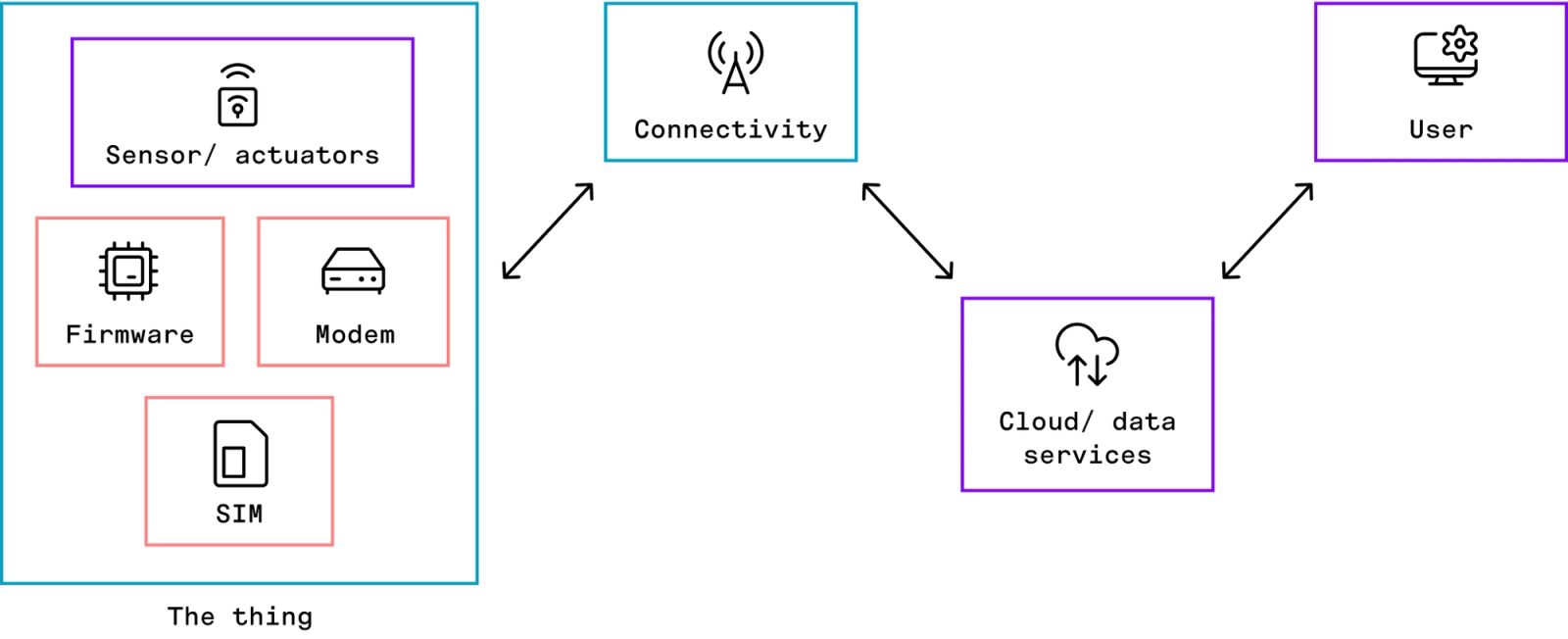An Innovator's Guide to Global IoT Deployments

It’s no secret that deploying a global fleet of IoT devices is complex. IoT managers have a lot to oversee, from managing manufacturing and distribution to understanding the global cellular landscape and everything in between.
Whether you are building a new product or expanding an existing product line to a new market, there are key considerations that can set you up for success. The first question you might ask is will my SIM connect in a new market? While it’s a great place to start, there are many other questions you should ask and factors to think about before expanding into a new market.
Getting started
Just as with any new initiative, it’s critical to understand the business strategy. From there, you can build a plan that will help you reach your goals. In the case of IoT, focusing your efforts on designing and prototyping will help you build a product that will scale globally.
Once you have the prototype, you can start to standardize and simplify as much as possible. Simultaneously, you will need to turn your attention to some key areas:
- Connectivity partners: Do you need a local connectivity provider? Should you turn to a global partner? Having an idea of your connectivity needs and global expansion plans can help guide you to find the right partner as you scale.
- Manufacturing partners: Where are manufacturers based? Will you need to cover import and export fees? What does distribution look like? Having contract manufacturers that understand the global landscape and can help you navigate is critical.
- Security: IoT devices, by their nature, open consumers and the manufacturers up to additional security concerns. Focusing on both physical and network security from the start will help protect you and those who use your products in the long run.
- Data and analytics: Connected devices are a rich source of data. Considering how much data you will collect from the start will help determine storage needs in the future.
A project that increases its scope once it’s planned leads to delays and increased costs. These initial considerations will help you understand and scope your IoT deployment to maintain timelines and costs.
Determining market fit
Having a plan is the first step in getting started. Before you expand to different markets, you need to understand product market fit. This is two fold:
- Will people buy and use the product in the market?
- Will the product operate in a new market?
The first question examines how a product will be adopted in a new market. For example, micromobility has grown in popularity in the United States, but does that translate to other countries? Or consider connected healthcare. Do local regulations allow remote patient monitoring or telehealth? And if so, are consumers comfortable using these types of devices? Depending on your solution, you might run into different hurdles in expanding to a new market.
The second question addresses the technical aspects of your product. Each country is unique and just because your product is certified in one country, does not guarantee certification in another market. In the U.S., devices require PTCRB certification, which ensures operators and device manufacturers are confident of a device’s interoperability with wireless networks. This is in addition to following carrier certifications, industry regulations, and any other additional government regulations in a particular country.

Aligning cross-functional teams
Deploying an IoT project doesn’t happen in a vacuum. It starts with research and development, with input from legal and compliance. Once the product is designed and built, sales and marketing must get it into users’ hands, followed by customer support to solve any potential issues.
Research and development
Before designing and building an IoT device, initial research is critical. This includes understanding local consumers in a market. Just because a product has great adoption in one market does not mean it will have that same success in another market. This is also a good time to bring in legal and compliance to ensure the product will be designed to meet regulatory requirements.
Once you understand the local customers and determine your IoT device is a good product market fit, product design, engineering, and manufacturing can get started. This will include incorporating import and export requirements and ensuring that the manufacturing process will include the appropriate testing and certifications are completed before shipping to a new market.
Legal and compliance
Planning for a global deployment is complex. Your legal and compliance teams will be key players in the process, helping across a variety of avenues including:
Import and export rules: customs in different countries have different rules and regulations.
Taxes: what will it cost to enter that market?
Regulatory requirements: are there specific certifications you’ll need?
There are also complexities as it relates to cellular connectivity. Your connectivity partner should be able to guide you to understand if you can work with a roaming provider or if you’ll need a native connection depending on where you are deploying. It’s also critical to ensure you have the right type of connectivity for your deployment.
Go-to-market teams
When the product has been developed, and you’ve met all of the legal and compliance requirements, it needs to get into the hands of users. Depending on supply chain challenges and the local market, sales may consider a few different avenues:
- Should you deploy a trial? This can give a bit of runway for shipping delays or allow for users to test the product to ensure it’s compatible with their needs before making a larger investment.
- Are there any cultural norms you should be aware of? Do you need to sell via channel partners?
- Are devices specifically designed for one market or can you quickly pivot and send to another market if adoption quickly accelerates?
All of these considerations will help determine how sales and marketing should engage. Once the product is in the hands of users, customer support becomes a key player to address any challenges a customer may have. In a global deployment, you’ll want to consider time differences and potential language barriers, determining if you need to expand the team to meet customer needs.
Regardless of the path you take, having harmony among teams is consistent for any company getting ready to deploy an IoT project.
Considerations for designing the product

There are many technical components that go into an IoT deployment. This means there are a lot of decisions that need to be made that could positively or negatively impact a project.
Modem selection
Modems are one of the components required in any cellular IoT device. They convert information produced from the sensors and firmware into a compatible form to be transmitted over a cellular network. Understanding your use case and the countries you are deploying in will help ensure you select the right modem. This includes making sure:
- The modem is compatible in the country and will continue to be compatible
- The bands your modem operates meet those offered in the country
- It has the proper radio access technologies for the country
Additionally, many countries require specific certifications. Selecting a modem with pre-certifications, like PTCRB, will reduce timelines on getting additional testing and approvals for your device. It is important to know that if you make any changes on the device, you will have to get additional certifications.
Firmware
The firmware of your device is the foundational software that enables the hardware to perform the functions that bring value to your business. In addition to testing the device’s radio frequency (RF) performance during certification, the device’s firmware must be tested and validated to ensure that it provides the best end-to-end experience and follows prescribed rules for the proper management of the network resources. For example, the firmware will be evaluated on the processes it uses to manage loss of connectivity to ensure that proper timeouts and retries are used that do not result in efficient use of the network resources, which could affect other devices on a local tower.
For IoT devices, firmware design, testing, and management is just as important as the overall product design.
SIM selection
There are several different types of SIM cards available and selecting the right one depends on your use case and your hardware. If your device will be in harsh conditions, you may want to use an industrial grade SIM or even an embedded SIM. Additionally, will the device be able to be accessed by a human to swap a SIM if needed? If not, you should leverage a SIM that can get over-the-air updates. eUICC SIMs provide an ability to future proof your fleet offering overing the air profile updates and multiple profiles.
Device certifications
We already touched on some certifications as it relates to modems, but you’ll need to think beyond the modem as well. Each country may have different certification requirements, and each hardware component may come with certain certifications. For example, in the U.S., you have regulatory requirements from the FCC, industry requirements like PTCRB, and carrier requirements. Knowing what you already have in addition to what’s required will help in the product design phase.
Connectivity Management
Once you’ve determined the components of the product, connectivity is the next piece of the puzzle. You may have heard the terms MVNO (mobile virtual network operator) and MNO (mobile network operator) before. MVNOs work with a number of different MNOs to provide connectivity through one SIM. An MNO is a wireless carrier, meaning you’d be working directly with the telecommunications provider that owns the cellular infrastructure in a particular market.
If you will be deploying in countries that have roaming restrictions and government regulations, it may make sense to work directly with a wireless carrier provider. MNOs in some countries may allow temporary roaming, but if you plan to stay in that country you’ll need to ensure permanent connectivity.
With an MVNO, a single SIM can be deployed in multiple markets. This brings flexibility into your manufacturing and supply chain process – where devices can be built to the same specifications regardless where they will be deployed. Fleet managers also have the benefit of leveraging one dashboard to manage all of their devices.
The hardware compatibility is another factor that may influence your decision. Is it carrier specific or is it compatible with the MVNO you are considering? The choice of selecting an MVNO or an MNO comes down to the environment, labor resources, performance requirements, and country-specific regulations.

Expect the unexpected
The global supply chain has hit some roadblocks including shipping delays, resulting in part shortages and longer lead times to deploy products. Think about creative ways to address these challenges across all parts of your business. From a manufacturing perspective, can you diversify your partners? Building your product to be global ready from the start will allow you to ship a product to a different market than initially intended. From a sales perspective, if there are delays in product reaching a market, think about shifting your sales process and offering trials to get initial products in customers’ hands.
What’s most important is the ability to be flexible and pivot in an uncertain market.
Automate
While it may not seem daunting to manage a small fleet, it becomes much more challenging as you grow your fleet in size and expand across the globe. Automating from the start will help you in the long run.
A dashboard can help simplify the process of managing a global fleet. Devices are automatically loaded into the system and provisioned by country. This makes it possible to set up alerts specific to a country to more easily monitor the local deployment. You can also zoom out to see the entire fleet and get an aggregate view of how devices are used in different markets, so you can make modifications as necessary.
Monitoring and fraud alerts created in a dashboard can then be built into your workplace messaging tools, so you can stay on top of your fleet in the way that’s easiest for you and your team. Leverage an API to bring alerts and data into the applications that work best for your team, and streamline fleet management, reporting, and more.
Be aware of hidden costs
It's easy to focus on the known costs when building and deploying a connected device: cost of designing and building each device, connectivity, labor, etc. But there are additional costs that come into play when deploying globally.
Shipping and logistics
While you may have accounted for the expected shipping costs of getting the device to the final destination, beware of the additional costs associated with entering a new market. This includes import and export fees and customs costs. You may also need to hire a customs broker to help expedite the process.
Labor
Entering new markets means new time zones and potentially new languages. Do you need to have local fleet managers to access devices on site? Can you access them remotely? Beyond accessing the devices, how will local customers be supported if there are issues or questions? Supporting the local market both from a technical and customer experience perspective can create overtime expenses or employees in new markets.
Questions to ask
✔️ Will my SIM connect?
✔️ What type of SIM should I use?
✔️ What bands of connectivity are available in a new market?
✔️ What does it take to ship to the new market?
✔️ Are there specific import requirements?
✔️ What are the regulatory requirements where I plan to deploy?
✔️ If I deploy in one country, what will happen if I expand to another country?
✔️ What are the implications for our manufacturing and supply chain
✔️ What support is available for our team?
✔️ What tools are available as I expand my fleet?
✔️ What skill level does my team need to manage the fleet?
✔️ What modem should I choose?
✔️ Do I need to certify my device?
✔️ How do I remotely manage my devices?
✔️ How do you manage loss of connectivity and data retries?
Common mistakes
There are a lot of considerations to think about when deploying a global fleet, but here are a few common mistakes that can be avoided.
Choosing the wrong providers
Selecting partners that can grow and scale with you from the start will save you time and money in the long run. For example, if you started with local connectivity and manufacturing partners and then decided to go global, don’t start over. Instead, find global partners that can take you on the right path for the future.
Skipping site survey
Before you decide to manufacture and deploy in a new market, spend some time in that market. Understand the environment and how the device works locally. Does the specific location have connectivity? Is your device compliant in the new country? Getting your device into the field and testing how it works is critical before launching an entire fleet.
Lack of infrastructure
Ensuring you have the right infrastructure set up in a country will help from initial deployment to ongoing maintenance. Some countries might require an importer of record, requiring that you work with a local partner that will receive your items. Additionally, have the right people on the ground to manage the devices in the field should something go wrong. These are all things you want in place before deploying in a new country.
Connectivity is not one size fits all Just because a device works in one country does not mean it will work in another. Make no assumptions. It’s important to understand the different requirements for different countries and carriers to avoid any pitfalls in the future.